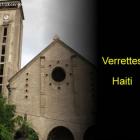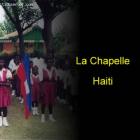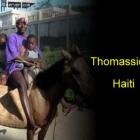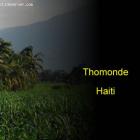ADVERTISEMENT
Energy Environment
The environment of Haiti is faced with huge problem. The total forest cover was approximately 2% in a country where 75% of energy demands were satisfied by wood fuel, and a lack of trees had in turn caused significant soil erosion.
Riviere Grise Getting a Facelift for its Levees
Laurent Lamothe, Prime Minister (PM), made a trip to Cul de Sac. Minister of Agriculture (MOA), Thomas Jacques, and other members of the government of Haiti (GOH) went along. Lamothe was there to monitor the construction project fortifying Rivière Grise's levees.
The Ministry of Treasury is financing this endeavor at a cost of 300 million gourdes. The work includes reinforcing levee infrastructure and replanting trees in the area. In April, the initial phase began and the second phase in now in progress.
Lamothe spoke to the media about what this project means to GOH and Cul de Sac residents. He said 50 years have elapsed since GOH has shored up the Rivière Grise levees. He said GOH's viewpoint concerning the populace, watershed, and agriculture is GOH must supply sufficient protection toward tropical storms, forcing people out of their homes, damaging the land. He added GOH understands its stewardship toward the land and its people.
Natural Park Quisqueya Lake Festival to Promote Eco-Tourism in a Ten Day Event
One of Haiti's natural resources, Natural Park Quisqueya (NPQ), is holding its first Lake Festival, beginning August 23rd and running through September 1st 2013. The Foundation for the Development of Alternative Tourism in Haiti (FONDTAH) and its partner, AfricAmerican Foundation (AAF), are initiators of the ten day and -night event.
One of the purposes of the festival, FONDTAH and AAF, say is to draw more eco-tourism to NPQ, so private investment will enable increased local-product exports. The idea is to show off the attractions that make NPQ a biodiversity hotspot, seat of unusual flora and fauna species.
The Lake Festival Committee has planned an event calendar to include art and culture; ecology and biodiversity forums; and multi-communal exchanges.
Recyclable Materials Used for Carnival Costume Wear
Haiti's Carnival of Flowers, being held for the second year running, is an expensive event for the government of Haiti to subsidize. Controversy it has posted a loss rather than a profit--as the GOH claims--has had calls from activists to stop holding it.
One solution helping defray costs is a group of entrepreneurs, who create Carnival costumes out of garbage: flowers, hats, and dresses. Haitian teens, part of Good Demen Haiti (GDH), are making flowers to adorn carnival hats, both made from recycled materials.
The members of the organization, at-risk youth, use plastic bottles delivered from waste collection centers in Port-au-Prince by garbage collectors. After thoroughly sanitizing the plastic containers the members work creating innovative art objects.
Public-Private Sector to Create New Energy System for Haiti
In an effort to turn around the ailing and fragile electricity system in Haiti, Prime Minister Lamothe met with U.S. officials to discuss how to give the Haitian population what it has long needed, a dependable and widely-available electricity system. Also present during the discussion was Cheryl Mills, a U.S. State Department representative, and Pamela White, the U.S. Ambassador to Haiti.
The two main problems, which beset Electricity of Haiti's (EdH) system are a diminished production capability and mismanagement of the system, which has led to significant losses in revenues. The government of Haiti (GOH) wants to form a partnership with the private sector to increase the production and availability of electricity. The World Bank (WB) and Inter-American Investment Bank (IAIB) are willing to partner with the GOH to achieve a well-managed and -operated power system for the Haitian people.
Botanica Garden or Jardin Botanique of Cayes a Green Reserve
Jardin Botanical Gardens of Les Cayes (JBC) was established in fall 2003. Its goals are replenishing ruined areas of biodiversity throughout Haiti and building infrastructure for maintaining biological legacy of island natural resources. JBC wishes to educate Haitian lawmakers legislating protections for Haiti's plant- and animal-life biodiversity is good for the future of eco-tourism, and for the country's morale.
The non-government organization, Botanical Gardens in Conservation (BGCI), works in tandem with JBC to set standards for creating, implementing, and sustaining botanical gardens and arboretums globally. They have defined markers that determine if a green space is a botanical garden, as opposed to civic or decorative parks.
Michel Martelly Proclaims 2013 as Year of the Environment
On "World Environment Day", Presidents Martelly and Medina of Haiti and the Dominican Republic (DR) inaugurated "Re-greening DR-Haiti" reforestation initiative in the town of Ouanaminthe. They participated in planting seeds to pledge their commitment to reach a green cover of 27% by 2020. Presently, tree and vegetation cover is at an all-time low of two percent. The consequence is dire: without trees to absorb rain water, the earth erodes and minerals in the top-soil wash away.
Besides the planting ceremony, Martelly and Medina stopped by Center of Germplasm and Production of Fruit and Forest Species of Dosmond, a trilateral partnership between Haiti, DR, and Cuba. They also visited the Massacre River Protection Program, an initiative to prevent flooding of low-lands in Ouanaminthe.
Haitian Villages slowly vanish as Lake Azuei grows
Since 2003, Haiti's Lake Azuei has risen 10 meters to its current elevation of 30. It has also grown to more than twice its original size since 2004 from 155 km2 to 354 km2. A study by students and faculty from City College of New York, who have used environmental equipment to monitor the lake, has gathered evidence, including satellite imagery, which shows that the Lake, once contained solely in Haiti, has now breached the border in the Dominican Republic by a few kilometers.
Interviews taken of the locals, including teachers, fishermen, politicians and farmers shows that not only some have been affected. Knowing the cause of the rising of the lake should aid officials in finding a means to stop it, as the current trend of relocation is only a temporary, wholly untenable fix.
Foret des Pins or The Pine Forest, a Haitian patrimony to safeguard
The long and wizened history of Foret des Pins, an expanse of forest consisting of coniferous tropical and sub-tropical plants, involves widespread deforestation for varying reasons over different points in time. Once, in the first years of the twentieth century, the Pine Forest was about 32,000 hectares, today, only 6,000 hectares remain.
Foret des Pins, which straddles the border of Haiti and neighboring Dominican Republic, has been ravaged through the years by natural disasters such as floods, landslides and earthquakes. It's also suffered under the hands of the government and the population. Widespread illegal logging led to a decree in 1937 declaring the forest as a 'special' site, and a law in 1962 against the clearing of sloping land. These steps did little to stop the cutting down of trees during the Duvalier years as well as the damage caused by farmers who clear the land to create space for their produce.
DloHaiti to use solar energy to power kiosks in Haiti
DloHaiti, a start-up based in Port-au-Prince has managed to accumulate a fund of $3.37 million from its round of Series A Funding. dloHaiti hopes that it will be able to use this money to quickly roll out its facilities of decentralized water production throughout the Republic of Haiti.
Jim Chu, CEO of dloHaiti told Global Water Intelligence (or GWI) after IFC InfraVentures initial seed investment that apart from himself, investments were made by Miyamoto International, Leopard Capital, FMO and IFC InfraVentures and that dloHaiti has a plan of going for scale-up financing of Series B sometime later.
Solutions for Deforestation Blocked by Government Incompetence
The island of Haiti was once blanketed by forests. Foreign countries, though, raped the land over many decades. During the era after America was founded, forests had decreased 5%, and during the French occupation, they declined another 45%. By 1956, only 20% remained. By the end of the 1980s, the percentage dropped to 2% left of forested terrain.
Zile Ayiti te yon fwa rekouvèr pa forè. Peyi etranje yo, fe kadejak sou peyi a pandan plizie deseni. Pandan epòk apre Amerik te fonde, forè te diminye 5%, ak pandan okipasyon Franse, yo te diminye yon lòt 45%. Le ou rive nan 1956, sèlman 20% rete. Rive nan fen 1980 yo, pousantaj la tonbe nan 2% kite nan tèren forè.
Our objective is to share with you news and information about Haiti and the people of Haiti. Traditions, habits and the way we were or grew are alive in this site. We highly recommend that you Subscribe to our Newsletter and also share with us some of the things that are memorable and made us unique people.

 Verrettes, Haiti
Verrettes, Haiti  Informative Marketing and Advertising in the Haitian Community
Informative Marketing and Advertising in the Haitian Community  La Chapelle, Haiti
La Chapelle, Haiti  Thomassique, Haiti
Thomassique, Haiti  Thomonde, Haiti
Thomonde, Haiti